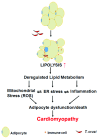Advances in understanding the role of adipose tissue and mitochondrial oxidative stress in Trypanosoma cruzi infection
- PMID: 31354939
- PMCID: PMC6652099
- DOI: 10.12688/f1000research.19190.1
Advances in understanding the role of adipose tissue and mitochondrial oxidative stress in Trypanosoma cruzi infection
Abstract
Trypanosoma cruzi, the etiologic agent of Chagas disease, causes a latent infection that results in cardiomyopathy. Infection with this pathogen is a major socio-economic burden in areas of endemic infection throughout Latin America. The development of chagasic cardiomyopathy is dependent on the persistence of this parasite in host tissues. Pathogenesis of this cardiomyopathy is multifactorial and research indicates that it includes microvascular dysfunction, immune responses to host and parasite antigens, and various vasoactive and lipid mediators produced by both the host and parasite. It has been demonstrated that T. cruzi persists in adipose tissue and uses fat as a nutritional niche in infected hosts. This chronic infection of adipose tissue plays an important role in the pathogenesis and persistence of this infection and involves mitochondrial stress responses as well as the production of various anti-inflammatory adipokines and pro-inflammatory cytokines by both white and brown adipose tissue. The changes in diet in endemic regions of infection have resulted in an epidemic of obesity that has significant implications for the pathogenesis of T. cruzi infection and the development of chagasic cardiomyopathy in infected humans.
Keywords: Adipocytes; Chagas Disease; Latency; Metabolism; Mitochondria; Trypanozoma cruzi.
Conflict of interest statement
No competing interests were disclosed.No competing interests were disclosed.No competing interests were disclosed.
Figures

References
Publication types
MeSH terms
Substances
LinkOut - more resources
Full Text Sources
Medical

